German Army General's Dress Tunic
CATEGORY: Version
SKU: 20.GOR.02.01.01.01.01.001.000
Estimated market value:
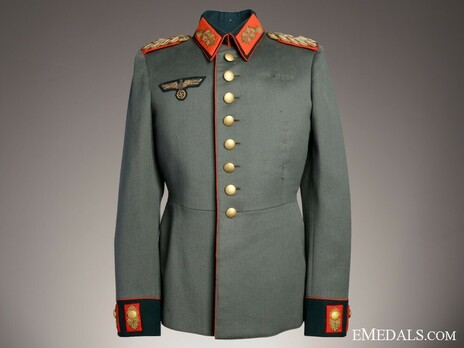
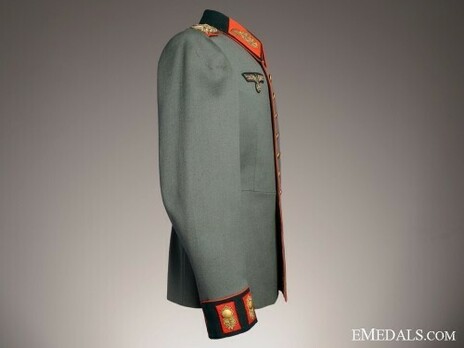
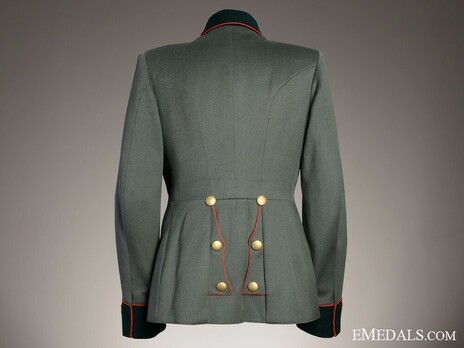
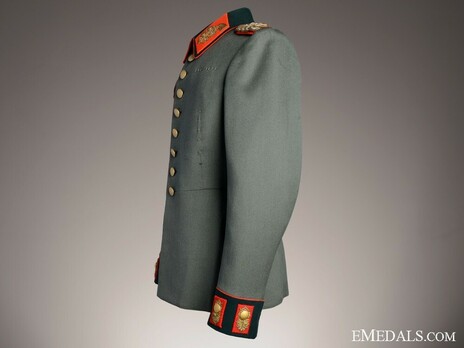
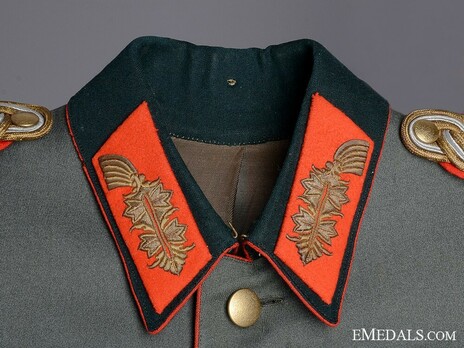
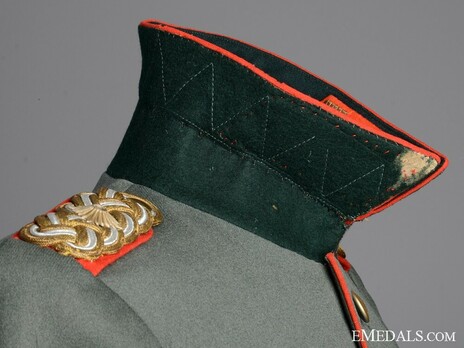
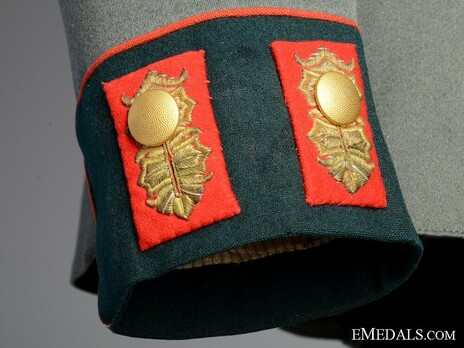
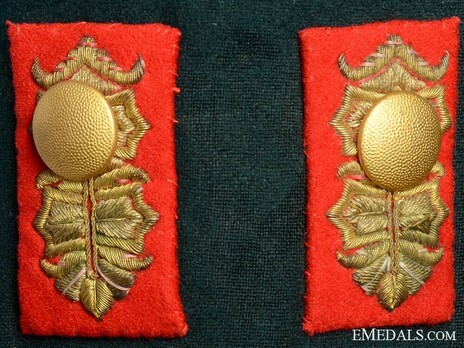
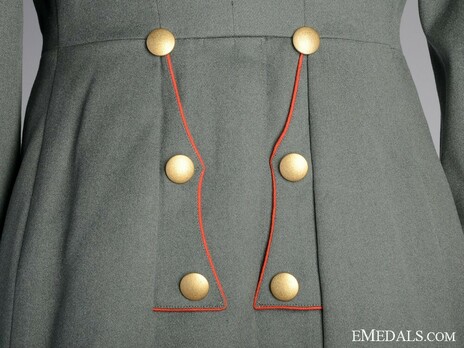
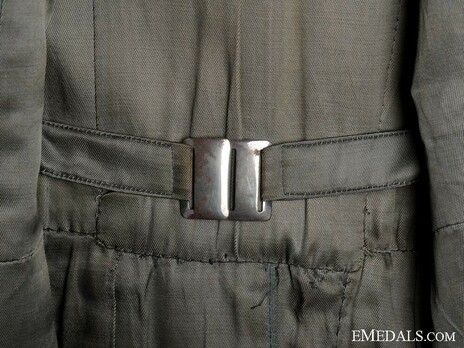
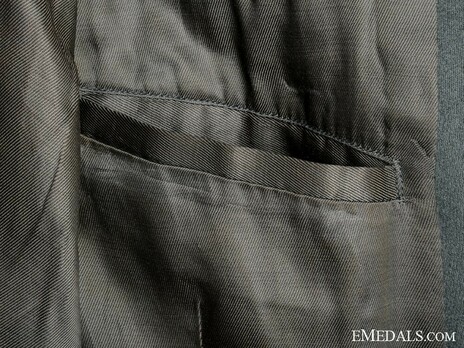
Estimated market value:
The tunic is fabricated from green wool and is trimmed with forest green wool on the collar and the simulated French cuffs, with red piping. It is adorned with gold braid and silver bullion wire shoulder boards, each with a silvered gilt pip attached, with red wool bases, held in place by gold gilt pebbled buttons. The collar tabs are in gold bullion wire with red wool bases and machine sewn to the collars. There is a dual hook and eye closure on the collar, ensuring a snug fit at the neckline. The inside of the collar has three holes, one on either side and one at the back, where clips once resided, used for the placement of a protective paper collar. The front is designed without pockets. The right breast exhibits an embroidered Wehrmacht eagle insignia, in gold-coloured bullion, interlaced with gold-coloured threading, that gives detail and definition to the wings and body of the eagle. The left breast has eight vertical thread loops arranged horizontally where a long ribbon bar once resided. Immediately below are two rows of horizontal thread loops, two to the left and six to the right arranged vertically, originally housing additional awards. The front is completed by a vertical row of eight gold gilt pebbled buttons on the right side, facing an equal number of reinforced button holes on the left, each button maker marked "HAITBAR BESONDER" on the reverse, trimmed in red piping on both open sides of the tunic. The rear of the tunic has a single vented tail skirt, with elongated straps on either side of the opening, again trimmed in red piping with three gold gilt buttons each. The cuffs each have two gold bullion General's insignias fronted by gold gilt pebbled buttons attached, with red wool bases. The inside is lined in a green rayon, with one large pocket on the left breast. There is a green rayon belt sewn in place at the waist on both sides, with polished, magnetic hardware, the right side buckle with a clip and the left side buckle with the receiving slot, allowing for a snug fit at the waistline. The sleeves are lined in white cotton with vertical stripes, with thin rayon loops sewn in place in each armpit. All the buttons appear to have their original stitching. The tunic has no visible size or manufacturer's markings and measures 400 mm across the shoulders and 680 mm in length overall.
The Dress Tunic was introduced on June 29, 1935. It was worn by all members of the Heer during parades and ceremonial occasions, and as a walking-out dress.
The tunic is field-grey with a dark blue-green collar and dark blue-green cuff-facings, and has branch colour piping down the edge of the front overlap, down the front edge of the collar and around the collar base, on the upper edges of the cuff-facings, and down the two tunic flaps in the back.
The collar has a stand-up and fall-down part. There are eight silver-white metal buttons down the front. Three more buttons are attached to each of the two tunic flaps on the back, and one non-functional button to each of the four cuff-facing patches. General ranks had gold-coloured buttons.
The tunic has no pockets, except for two hidden pockets in the tunic tail.
Tunics for higher ranked soldiers are generally made from materials of superior quality. There are four different rank segments wearing slightly but distinctively different tunics: EMs (enlisted men), NCOs (non-commissioned officers), officers, and generals. General rank tunics can be identified not only by the gilt buttons, but also the ornate gilt embroideries on their cuff and collar patches. All other ranks had so-called Litzen (flat braid) on their cuff and collar patches. Those of officers were made of superior quality material and are more elaborate in design compared to the rather plain ones of EMs and NCOs. The difference between EM and NCO tunics lies in another type of flat braid, so-called Tresse (trimming), along the edges of the cuffs and collars, similar to those on NCO rank shoulder straps.
Tunic insignia, such as breast eagles, collar tabs, or shoulder boards will differ from rank to rank. For more information, see the appropriate entries in the Insignia subcategory.
Production of the dress tunic was discontinued with the outbreak of the war.
A special version was introduced on September 15, 1939 for members of the Infantry Regiment “Großdeutschland”. It has white piping and white metal buttons. The collar Litzen are elongated. Officer tunics have two collar Litzen, while those for EMs and NCOs only have one. There are three cuff-patches per cuff, which are of the so-called “French” cuff patterns.
Only very few jackets were ever given out due to the outbreak of the war, and it was never manufactured in great numbers.
Chaplains wore an Überrock (frock coat) in place of the Dress Tunic. For more information, see the Coats subcategory.
Branch colours on German Heer headgear was as follows:
Black was worn by Engineer units.
Black/White was worn by Panzer Engineers.
Copper Brown was worn by Motorcycle personnel.
Light Brown was worn by Signals units until 1936, and by Construction troops.
Carmine was worn by the Führer Staff, General Staff Officers, Staff Officers of the Supreme Command of the Army, and all Veterinary branches.
Bordeaux Red was worn by Smoke & Chemical personnel.
Wine Red was worn by Judicial officials.
Bright Red was worn by Generals, Artillery units, and Ordnance Officers (until 1944).
Rose or Pink was worn by all Armored units (including Panzer troops, and Schützen Brigade Staff).
Orange was worn by Recruiting personnel, Ordnance troops, Ordnance Officers (since 1944), and Field Gendarmerie units.
Bright yellow was worn by Cavalry units, and Light Division Staff.
Lemon yellow was worn by Signal units.
White was worn by Infantry units.
Light Grey was worn by Propaganda personnel.
Grey-Blue was worn by Sonderführer (Specialist Officers).
Violet was worn by Chaplains and Field Bishops.
Cornflower Blue was worn by Medical units, and Supply units.
Bright Blue was worn by Transport troops.
Bright Green was worn by Jäger and Mountain units.
Grass Green was worn by Panzer Grenadier units (Armored Infantry).
Dark Green was worn by Administrative personnel.

Comments
Sign in to comment and reply.


Scroll Top